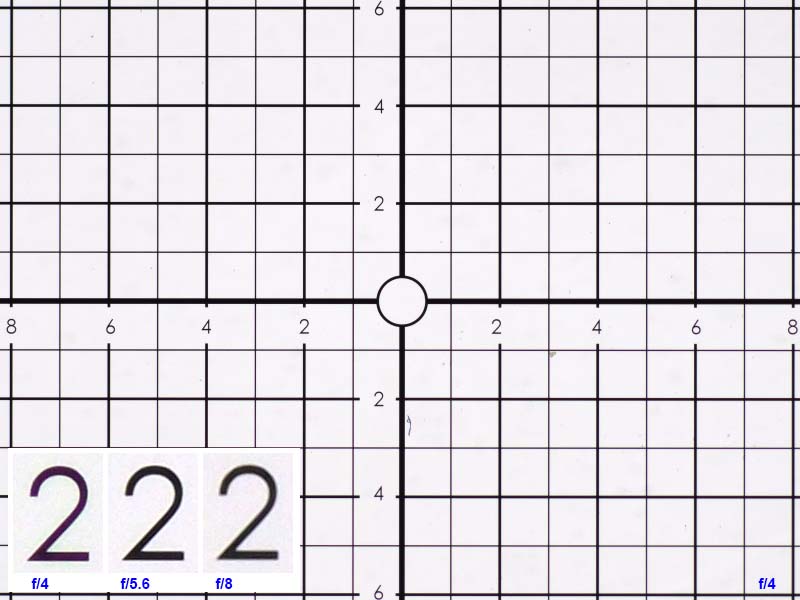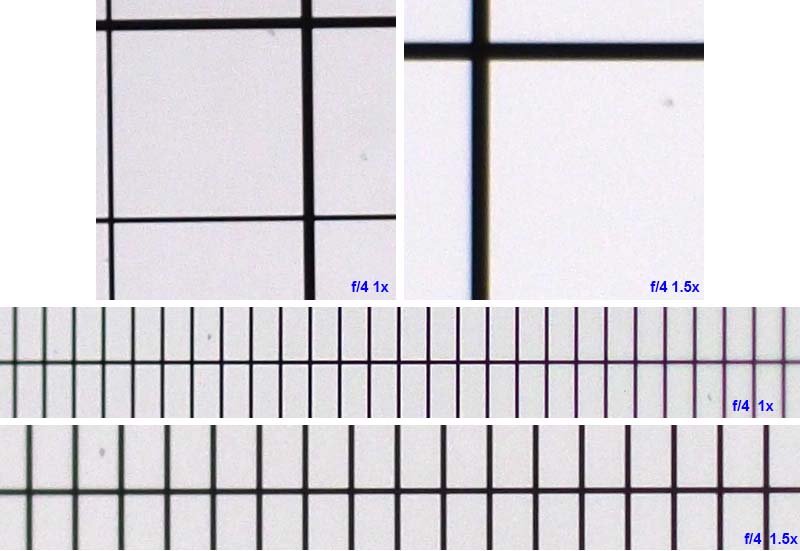Zeiss S-Planar 74 mm f/4This page discusses tests of the Zeiss S-Planar 74 mm f/4, and its performance in macrophotography. I tested this lens several years ago, and used it only sporadically. Although its resolution is remarkably good around its optimal magnification of 1x, results were not the best with respect to contrast and dynamic range. This is a fairly small lens, with a narrow front end of the barrel (about 19 mm in diameter). Coupled with the large working distance (almost 120 mm at 1x), this lens makes it very comfortable to place all types of illumination close to the subject. See the above link for a further description of the physical appearance of this lens. Mounting the lensThe lens mount has a proprietary M32 x 0.5 male mounting thread. There is no filter mount, but, as mentioned on my earlier test page, the barrel front fits snugly within a plastic 35 mm film canister, which can be used to make lens shades and lens caps. Using the lens in practiceThis lens must be used on bellows or a stack of extension tubes. For this test, I mounted it on an Olympus OM Telescopic Auto Tube 65–116 via M42x1 adapters. I further used a Micro 4/3 adapter at the rear for connection with the Olympus E-M1 Mark II test camera. With this setup, the lens provides magnifications ranging from 0.97x to 1.66x. If desired, higher magnifications can be achieved by adding M42 extension rings. The aperture scale of this lens indicates the effective aperture at 1x. For example, the fully open position is marked as f/8. In this page, however, I use the nominal lens aperture for consistency with the majority of other lenses, i.e. fully open corresponds to f/4. Tests by other usersThis lens has been tested, among others, at coinimaging.com. The general opinion is that it is an excellent lens around 1x as far as resolution and lack of distortion are concerned, but contrast is not as good as with more modern lenses. The fully open aperture of f/4 gives the best image resolution. The purpose of this page is to test the lens on Micro 4/3, and I am not aware of any previous extensive test on this format. Lens testFor this test, I used magnifications of 1x and 1.5x, and in addition 1.66x (the maximum extension of the setup). 
Inset: 1:1 pixel crops at different apertures . Image quality is clearly best at 1x and f/4. Stopping down to f/5.6 already reduces resolution because of diffraction blurring. I have a couple of lenses with higher resolution than this, but they are f/2.8 or faster, and designed for use fully open. They are also true apochromatic lenses, which means they display no detectable axial or transversal chromatic aberration (see also below). 
Inset: 1:1 pixel crops at different apertures . At f/4 and 1.5x, there is a moderate amount of axial chromatic aberration, which disappears at f/5.6 and higher. Image resolution at f/5.6 is very slightly worse than at f/4, but is significantly fuzzier at f/8. f/5.6 is the best overall aperture at this magnification. 
Inset: 1:1 pixel crops at different apertures . At 1.66x, resolution is moderately lower than at 1.5x at all apertures. The remaining image characteristics are not significantly different from 1.5x, including axial chromatic aberration. f/5.6 remains the optimal aperture also at this magnification, but the lower resolution may be a problem if the best image quality is necessary. 
Top row: transversal chromatic aberration in top left corner of frame. Middle and bottom rows: axial chromatic aberration at center of frame. Transversal chromatic aberration is essentially absent at 1x and at all apertures. A moderate amount is present at 1.5x and higher. Axial chromatic aberration is present at f/4 at all tested magnifications, but lesser than in most other lenses I tested. Only true apochromatic lenses and a handful of other lenses of generally high quality perform better than the Zeiss S-Planar 74 mm. As a test of contrast, I imaged a silicon wafer at 1x. Results are good, with none of the reduced contrast I observed in other tests of this lens I made years ago. It is possible that the setup I used for the current test is better flocked to prevent loss of contrast than the bellows I use in my earlier test, and illumination better controlled to avoid stray light from entering the lens (however, I did not use a lens shade in the present test, which is always a good precaution). Another good precaution that I did not take is restricting illumination to a subject area not much larger than the field of view of the lens (I evenly illuminated the whole 6" test wafer in this test). This results suggest that the lens is not as sensitive to flare and stray illumination as I feared. Contrast and dynamic range, however, are not quite as high as I would expect from more modern lenses, especially in the darkest and lightest areas. Aside for a sharper image at f/4 (as expected, and visible only when pixel-peeping), I can see no substantial difference between f/4 and f/5.6. ConclusionsThe Zeiss S-Planar 74 mm f/4 is an excellent lens at 1x, characterized by high resolution and very low distortion. It can be used at 1.5x, with the penalty of an increase in axial chromatic aberration. In appropriate conditions, contrast is sufficient for most subjects, although not as high as with more modern lenses. High working distance and narrow front of the barrel are additional advantages. |